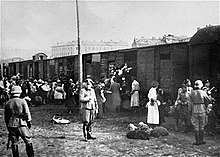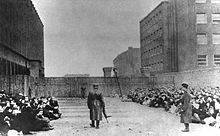
The Final Solution or the Final Solution to the Jewish Question was a Nazi plan for the genocide of individuals they defined as Jews during World War II. The "Final Solution to the Jewish question" was the official code name for the murder of all Jews within reach, which was not restricted to the European continent. This policy of deliberate and systematic genocide starting across German-occupied Europe was formulated in procedural and geopolitical terms by Nazi leadership in January 1942 at the Wannsee Conference held near Berlin, and culminated in the Holocaust, which saw the murder of 90% of Polish Jews, and two-thirds of the Jewish population of Europe.

Nazi Germany used six extermination camps, also called death camps, or killing centers, in Central Europe during World War II to systematically murder over 2.7 million people – mostly Jews – in the Holocaust. The victims of death camps were primarily murdered by gassing, either in permanent installations constructed for this specific purpose, or by means of gas vans. The six extermination camps were Chełmno, Belzec, Sobibor, Treblinka, Majdanek and Auschwitz-Birkenau. Extermination through labour was also used at the Auschwitz and Majdanek death camps. Millions were also murdered in concentration camps, in the Aktion T4, or directly on site.

The Warsaw Ghetto was the largest of the Nazi ghettos during World War II and the Holocaust. It was established in November 1940 by the German authorities within the new General Government territory of occupied Poland. At its height, as many as 460,000 Jews were imprisoned there, in an area of 3.4 km2 (1.3 sq mi), with an average of 9.2 persons per room, barely subsisting on meager food rations. Jews were deported from the Warsaw Ghetto to Nazi concentration camps and mass-killing centers. In the summer of 1942, at least 254,000 ghetto residents were sent to the Treblinka extermination camp during Großaktion Warschau under the guise of "resettlement in the East" over the course of the summer. The ghetto was demolished by the Germans in May 1943 after the Warsaw Ghetto Uprising had temporarily halted the deportations. The total death toll among the prisoners of the ghetto is estimated to be at least 300,000 killed by bullet or gas, combined with 92,000 victims of starvation and related diseases, the Warsaw Ghetto Uprising, and the casualties of the final destruction of the ghetto.

Mordechai Anielewicz was the leader of the Jewish Combat Organization during the Warsaw Ghetto Uprising; the largest Jewish resistance movement during the Second World War. Anielewicz inspired further rebellions in both ghettos and extermination camps with his leadership. His character was engraved as a symbol of courage and sacrifice, and was a major figure of Jewish resistance during the Holocaust.
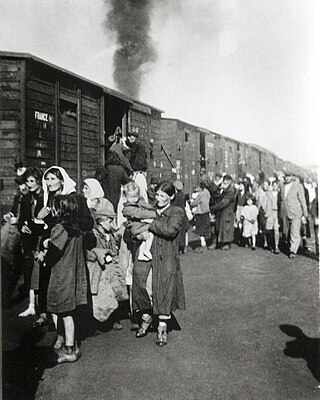
Operation Reinhard or Operation Reinhardt was the codename of the secret German plan in World War II to exterminate Polish Jews in the General Government district of German-occupied Poland. This deadliest phase of the Holocaust was marked by the introduction of extermination camps. The operation proceeded from March 1942 to November 1943; about 1.47 million or more Jews were murdered in just 100 days from late July to early November 1942, a rate which is approximately 83% higher than the commonly suggested figure for the kill rate in the Rwandan genocide. In the time frame of July to October 1942, the overall death toll, including all killings of Jews and not just Operation Reinhard, amounted to two million killed in those four months alone. It was the single fastest rate of genocidal killing in history.
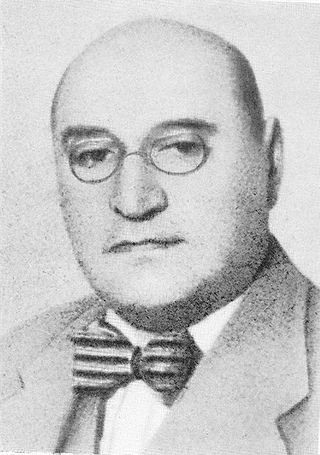
Adam Czerniaków was a Polish engineer and senator who was head of the Warsaw Ghetto Jewish Council (Judenrat) during World War II. He committed suicide on 23 July 1942 by swallowing a cyanide pill, a day after the commencement of mass extermination of Jews known as the Grossaktion Warsaw.

The Jewish Combat Organization was a World War II resistance movement in occupied Poland, which was instrumental in organizing and launching the Warsaw Ghetto Uprising. ŻOB took part in a number of other resistance activities as well.

The Warsaw Ghetto Uprising was the 1943 act of Jewish resistance in the Warsaw Ghetto in German-occupied Poland during World War II to oppose Nazi Germany's final effort to transport the remaining ghetto population to the gas chambers of the Majdanek and Treblinka extermination camps.
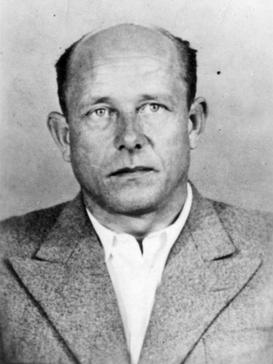
Hermann Julius Höfle, also Hans (or) Hermann Hoefle, was an Austrian-born SS commander and Holocaust perpetrator during the Nazi era. He was deputy to Odilo Globočnik in the Aktion Reinhard program, serving as his main deportation and extermination expert. Arrested in 1961 in connection with these crimes, Höfle died via suicide by hanging in prison before he was tried.

Umschlagplatz was the term used during The Holocaust to denote the holding areas adjacent to railway stations in occupied Poland where Jews from ghettos were assembled for deportation to Nazi death camps. The largest collection point was in Warsaw next to the Warsaw Ghetto. In 1942 between 254,000 – 265,000 Jews passed through the Warsaw Umschlagplatz on their way to the Treblinka extermination camp during Operation Reinhard, the deadliest phase of the Holocaust in Poland. Often those awaiting the arrival of Holocaust trains, were held at the Umschlagplatz overnight. Other examples of Umschlagplatz include the one at Radogoszcz station - adjacent to the Łódź Ghetto - where people were sent to Chełmno extermination camp and Auschwitz.

Ferdinand von Sammern-Frankenegg was an Austrian SS functionary (Brigadeführer) during the Nazi era. He was born in Grieskirchen. Von Sammern-Frankenegg served in World War I as a member of the Kaiserschützen, then of the K.u.k. Feldjäger and then after Austria-Hungary had formally surrendered, in the German Freikorps Oberland and the Steirischer Heimatschutz. Ferdinand von Sammern-Frankenegg earned his PhD in legal studies at the University of Innsbruck in 1922. He had been a member of the dueling fraternity Universitätssängerschaft Skalden zu Innsbruck. Von Sammern-Frankenegg worked as a lawyer in Peuerbach.

Operation Reinhard in Kraków, often referred to by its original codename in German as Aktion Krakau, was a major 1942 German Nazi operation against the Jews of Kraków, Poland. It was headed by SS and Police Leader Julian Scherner from the Waffen-SS. The roundup was part of the countrywide Aktion Reinhard, the mass murder of Polish Jews in the so-called General Government under the command of SS und Polizeiführer Odilo Globočnik.

Holocaust trains were railway transports run by the Deutsche Reichsbahn and other European railways under the control of Nazi Germany and its allies, for the purpose of forcible deportation of the Jews, as well as other victims of the Holocaust, to the Nazi concentration, forced labour, and extermination camps.

Kalman Taigman also Teigman Hebrew: קלמן טייגמן was an Israeli citizen who was born and grew up in Warsaw, Poland. One of the former members of the Jewish Sonderkommando who escaped from the Treblinka extermination camp during the prisoner uprising of August 1943, Taigman later testified at the 1961 Eichmann Trial held in Jerusalem.

During World War II, Trawniki men were Central and Eastern European Nazi collaborators, consisting of either volunteers or recruits from prisoner-of-war camps set up by Nazi Germany for Soviet Red Army soldiers captured in the border regions during Operation Barbarossa launched in June 1941. Thousands of these volunteers served in the General Government territory of German-occupied Poland until the end of World War II. Trawnikis belonged to a category of Hiwis, Nazi auxiliary forces recruited from native subjects serving in various jobs such as concentration camp guards.

Többens and Schultz was a Nazi German textile manufacturing conglomerate making German uniforms, socks and garments in the Warsaw Ghetto and elsewhere, during the occupation of Poland in World War II. It was owned and operated by two major war profiteers: Fritz Emil Schultz from Danzig, and a convicted war criminal, Walter C. Többens.
Chaike BelchatowskaSpiegel, also called Helen, was a Jewish resistance fighter and one of the last survivors in the 1943 Warsaw Ghetto Uprising against the Nazis.

In the best-known photograph taken during the 1943 Warsaw Ghetto Uprising, a boy holds his hands over his head while SS-Rottenführer Josef Blösche points a submachine gun in his direction. The boy and others hid in a bunker during the final liquidation of the ghetto, but they were caught and forced out by German troops. After the photograph was taken, all of the Jews in the photograph were marched to the Umschlagplatz and deported to Majdanek extermination camp or Treblinka. The exact location and the photographer are not known, and Blösche is the only person in the photograph who can be identified with certainty. The image is one of the most famous photographs of the Holocaust, and the boy came to represent children in the Holocaust, as well as all Jewish victims.

A well-known Holocaust photograph depicts three Jewish women who fought in the Warsaw Ghetto Uprising, took shelter in a bunker with a weapons cache, and were forced out by SS soldiers. One of the women, Bluma Wyszogrodzka (center), was shot. The other two, Małka Zdrojewicz (right) and Rachela Wyszogrodzka (left) were marched to the Umschlagplatz and deported to Majdanek concentration camp, where Wyszogrodzka was murdered.
Georg Wilhelm Johannes Michalsen was a German SS-Sturmbannführer. During the Second World War, he was involved in the systematic deportation and murder of Polish Jews and later served as the SS and Police Leader in Trieste. Decades after the war, he was tried as an accomplice to murder, convicted and sentenced to twelve years in prison.
